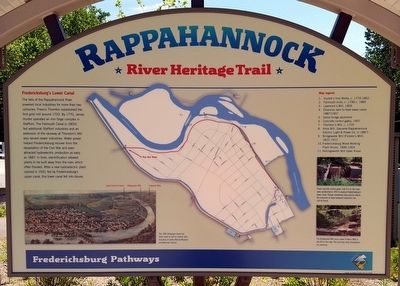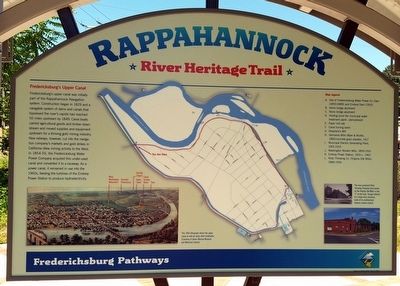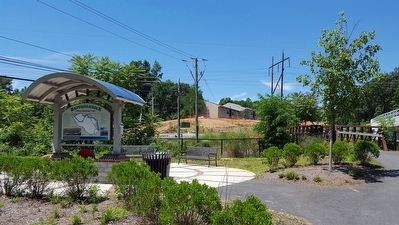Fredericksburg, Virginia — The American South (Mid-Atlantic)
Rappahannock River Heritage Trail
Fredericksburg Pathways
Fredericksburg’s Lower Canal
The falls of the Rappahannock River powered local industries for more than two centuries. Francis Thornton established the first grist mill around 1720. By 1770, James Hunter operated an iron forge complex in Stafford. The Falmouth Canal (c.1800) fed additional Stafford industries and an extension of the raceway at Thornton's Mill also served newer industries. Water power helped Fredericksburg recover from the devastation of the Civil War and even attracted hydroelectric production as early as 1887. In time, electrification allowed plants to be built away from the river, which often flooded. After a new hydroelectric plant opened in 1910, fed by Fredericksburg's upper canal, this lower canal fell into disuse.
Map legend:
1. Hunter's lron Works, c. 1770-1862
2. Falmouth mills, c. 179O-c. 1880
3. Lawrence's Mill, 1806
4. Diversion dam to feed lower canal, 1887/1907
5. Stone bridge abutment
6. Concrete control gates, 1907
7. Thornton's Mill, c. 1720
8. Knox Mill, (became Rappahannock Electric Light & Power Co. in 1887)
9. Bridgewater Mill (Ficklen's Mill), 1822-1912
10. Fredericksburg Wood Working Plant (Knox), 1896-1904
11. Hollingsworth Mill (later Knox)
(captions)
This 1856 lithograph shows the lower canal as well as several mills. (Courtesy of James Monroe Museum and Memorial Library)
These concrete control gates (site #6 on the map) were constructed in 1907 to improve Fredericksburg’s lower canal. Though sometimes obscured by nature, the remnants of water-powered industries can still be found.
The Bridgewater Mill (once called Ficklen’s Mill) is site #9 on the map. The surviving stone foundations are extensive.
(side 2)
Fredericksburg's Upper Canal
Fredericksburg’s upper canal was initially part of the Rappahannock Navigation system. Construction began in 1829 and a navigable system of dams and canals that bypassed the river's rapids had reached 50 miles upstream by 1849. Canal boats carried agricultural goods and timber downstream and moved supplies and equipment upstream for a thriving gold mining industry. New railways, however, cut into the navigation company's markets and gold strikes in California drew mining activity to the West. In 1854-55, the Fredericksburg Water Power Company acquired this under-used canal and converted it to a raceway. As a power canal, it remained in use into the 1960s, feeding the turbines of the Embrey Power Station to produce hydroelectricity.
Map legend:
A. Site of Fredericksburg Water Power Co. Dam (1855/1889) and Embrey Dam (1910)
B. Stone bridge abutment
C. Stone bridge abutment
D. Holding pond (for municipal water treatment plant—demolished)
E. Paper mill site
F. Canal turning basin
G. Shepherd's Mill
H. Germania Mills (Myer & Brulle), 1866/concrete grain elevator, 1917
I. Municipal Electric Generating Plant, 1901-1919
J. Washington Woolen Mills, 1859-1910
K. Embrey Power Station, 1910-c. 1962
L. Klotz Throwing Co. (Virginia Silk Mills), 1889-1934
(captions)
This 1856 lithograph shows the lower canal as well as several mills. (Courtesy of James Monroe Museum and Memorial Library)
The once prominent Klotz Throwing Company (also known as the Virginia Silk Mills) is site “L” on the map. Though reduced to a single story structure, some of its architectural features remain evident.
Topics. This historical marker is listed in these topic lists: Industry & Commerce • Man-Made Features • Waterways & Vessels.
Location. 38° 18.988′ N, 77° 29.135′ W. Marker is in Fredericksburg, Virginia. Marker can be reached from the intersection of Fall Hill Avenue (Virginia Route 639) and Normandy Avenue, on the right when traveling north. Located at the parking lot for the River Heritage Trail. Touch for map. Marker is in this post office area: Fredericksburg VA 22401, United States of America. Touch for directions.
Other nearby markers. At least 8 other markers are within walking distance of this marker. Confederate and Federal Defenses in May 1863 (within shouting distance of this marker); Confederate Defenses in December 1862 (within shouting distance of this marker); A Once Promising Canal Becomes a Raceway (within shouting distance of this marker); Fall Hill Road (approx. ¼ mile away); Tactical Terrain (approx. ¼ mile away); Industrial Interlude (approx. ¼ mile away); Embrey Dam (approx. 0.4 miles away); Falls of the Rappahannock River (approx. 0.4 miles away). Touch for a list and map of all markers in Fredericksburg.
Credits. This page was last revised on February 2, 2023. It was originally submitted on June 20, 2016, by Bernard Fisher of Richmond, Virginia. This page has been viewed 427 times since then and 33 times this year. Photos: 1, 2, 3. submitted on June 20, 2016, by Bernard Fisher of Richmond, Virginia.


